Yi Zhou
E-MoFlow: Learning Egomotion and Optical Flow from Event Data via Implicit Regularization
Oct 14, 2025



Abstract:The estimation of optical flow and 6-DoF ego-motion, two fundamental tasks in 3D vision, has typically been addressed independently. For neuromorphic vision (e.g., event cameras), however, the lack of robust data association makes solving the two problems separately an ill-posed challenge, especially in the absence of supervision via ground truth. Existing works mitigate this ill-posedness by either enforcing the smoothness of the flow field via an explicit variational regularizer or leveraging explicit structure-and-motion priors in the parametrization to improve event alignment. The former notably introduces bias in results and computational overhead, while the latter, which parametrizes the optical flow in terms of the scene depth and the camera motion, often converges to suboptimal local minima. To address these issues, we propose an unsupervised framework that jointly optimizes egomotion and optical flow via implicit spatial-temporal and geometric regularization. First, by modeling camera's egomotion as a continuous spline and optical flow as an implicit neural representation, our method inherently embeds spatial-temporal coherence through inductive biases. Second, we incorporate structure-and-motion priors through differential geometric constraints, bypassing explicit depth estimation while maintaining rigorous geometric consistency. As a result, our framework (called E-MoFlow) unifies egomotion and optical flow estimation via implicit regularization under a fully unsupervised paradigm. Experiments demonstrate its versatility to general 6-DoF motion scenarios, achieving state-of-the-art performance among unsupervised methods and competitive even with supervised approaches.
Character Mixing for Video Generation
Oct 06, 2025Abstract:Imagine Mr. Bean stepping into Tom and Jerry--can we generate videos where characters interact naturally across different worlds? We study inter-character interaction in text-to-video generation, where the key challenge is to preserve each character's identity and behaviors while enabling coherent cross-context interaction. This is difficult because characters may never have coexisted and because mixing styles often causes style delusion, where realistic characters appear cartoonish or vice versa. We introduce a framework that tackles these issues with Cross-Character Embedding (CCE), which learns identity and behavioral logic across multimodal sources, and Cross-Character Augmentation (CCA), which enriches training with synthetic co-existence and mixed-style data. Together, these techniques allow natural interactions between previously uncoexistent characters without losing stylistic fidelity. Experiments on a curated benchmark of cartoons and live-action series with 10 characters show clear improvements in identity preservation, interaction quality, and robustness to style delusion, enabling new forms of generative storytelling.Additional results and videos are available on our project page: https://tingtingliao.github.io/mimix/.
Annotating Training Data for Conditional Semantic Textual Similarity Measurement using Large Language Models
Sep 17, 2025Abstract:Semantic similarity between two sentences depends on the aspects considered between those sentences. To study this phenomenon, Deshpande et al. (2023) proposed the Conditional Semantic Textual Similarity (C-STS) task and annotated a human-rated similarity dataset containing pairs of sentences compared under two different conditions. However, Tu et al. (2024) found various annotation issues in this dataset and showed that manually re-annotating a small portion of it leads to more accurate C-STS models. Despite these pioneering efforts, the lack of large and accurately annotated C-STS datasets remains a blocker for making progress on this task as evidenced by the subpar performance of the C-STS models. To address this training data need, we resort to Large Language Models (LLMs) to correct the condition statements and similarity ratings in the original dataset proposed by Deshpande et al. (2023). Our proposed method is able to re-annotate a large training dataset for the C-STS task with minimal manual effort. Importantly, by training a supervised C-STS model on our cleaned and re-annotated dataset, we achieve a 5.4% statistically significant improvement in Spearman correlation. The re-annotated dataset is available at https://LivNLP.github.io/CSTS-reannotation.
Deep Visual Odometry for Stereo Event Cameras
Sep 10, 2025Abstract:Event-based cameras are bio-inspired sensors with pixels that independently and asynchronously respond to brightness changes at microsecond resolution, offering the potential to handle state estimation tasks involving motion blur and high dynamic range (HDR) illumination conditions. However, the versatility of event-based visual odometry (VO) relying on handcrafted data association (either direct or indirect methods) is still unreliable, especially in field robot applications under low-light HDR conditions, where the dynamic range can be enormous and the signal-to-noise ratio is spatially-and-temporally varying. Leveraging deep neural networks offers new possibilities for overcoming these challenges. In this paper, we propose a learning-based stereo event visual odometry. Building upon Deep Event Visual Odometry (DEVO), our system (called Stereo-DEVO) introduces a novel and efficient static-stereo association strategy for sparse depth estimation with almost no additional computational burden. By integrating it into a tightly coupled bundle adjustment (BA) optimization scheme, and benefiting from the recurrent network's ability to perform accurate optical flow estimation through voxel-based event representations to establish reliable patch associations, our system achieves high-precision pose estimation in metric scale. In contrast to the offline performance of DEVO, our system can process event data of \zs{Video Graphics Array} (VGA) resolution in real time. Extensive evaluations on multiple public real-world datasets and self-collected data justify our system's versatility, demonstrating superior performance compared to state-of-the-art event-based VO methods. More importantly, our system achieves stable pose estimation even in large-scale nighttime HDR scenarios.
Rectified Robust Policy Optimization for Model-Uncertain Constrained Reinforcement Learning without Strong Duality
Aug 24, 2025

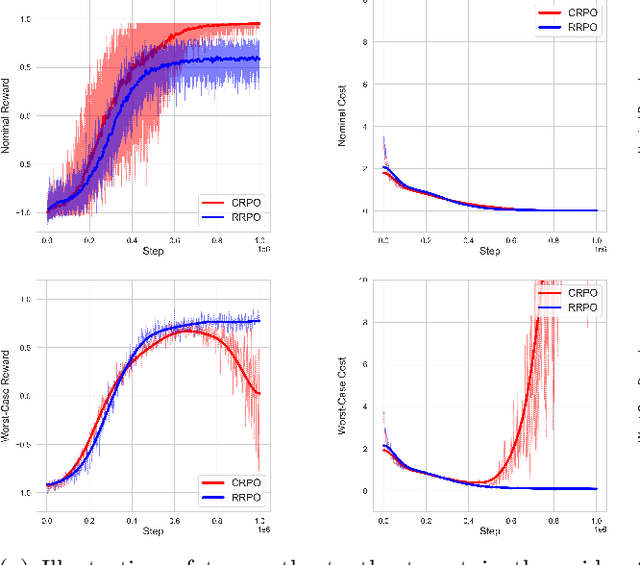

Abstract:The goal of robust constrained reinforcement learning (RL) is to optimize an agent's performance under the worst-case model uncertainty while satisfying safety or resource constraints. In this paper, we demonstrate that strong duality does not generally hold in robust constrained RL, indicating that traditional primal-dual methods may fail to find optimal feasible policies. To overcome this limitation, we propose a novel primal-only algorithm called Rectified Robust Policy Optimization (RRPO), which operates directly on the primal problem without relying on dual formulations. We provide theoretical convergence guarantees under mild regularity assumptions, showing convergence to an approximately optimal feasible policy with iteration complexity matching the best-known lower bound when the uncertainty set diameter is controlled in a specific level. Empirical results in a grid-world environment validate the effectiveness of our approach, demonstrating that RRPO achieves robust and safe performance under model uncertainties while the non-robust method can violate the worst-case safety constraints.
Temporal and Rotational Calibration for Event-Centric Multi-Sensor Systems
Aug 18, 2025Abstract:Event cameras generate asynchronous signals in response to pixel-level brightness changes, offering a sensing paradigm with theoretically microsecond-scale latency that can significantly enhance the performance of multi-sensor systems. Extrinsic calibration is a critical prerequisite for effective sensor fusion; however, the configuration that involves event cameras remains an understudied topic. In this paper, we propose a motion-based temporal and rotational calibration framework tailored for event-centric multi-sensor systems, eliminating the need for dedicated calibration targets. Our method uses as input the rotational motion estimates obtained from event cameras and other heterogeneous sensors, respectively. Different from conventional approaches that rely on event-to-frame conversion, our method efficiently estimates angular velocity from normal flow observations, which are derived from the spatio-temporal profile of event data. The overall calibration pipeline adopts a two-step approach: it first initializes the temporal offset and rotational extrinsics by exploiting kinematic correlations in the spirit of Canonical Correlation Analysis (CCA), and then refines both temporal and rotational parameters through a joint non-linear optimization using a continuous-time parametrization in SO(3). Extensive evaluations on both publicly available and self-collected datasets validate that the proposed method achieves calibration accuracy comparable to target-based methods, while exhibiting superior stability over purely CCA-based methods, and highlighting its precision, robustness and flexibility. To facilitate future research, our implementation will be made open-source. Code: https://github.com/NAIL-HNU/EvMultiCalib.
Uncertainty-aware Cross-training for Semi-supervised Medical Image Segmentation
Aug 12, 2025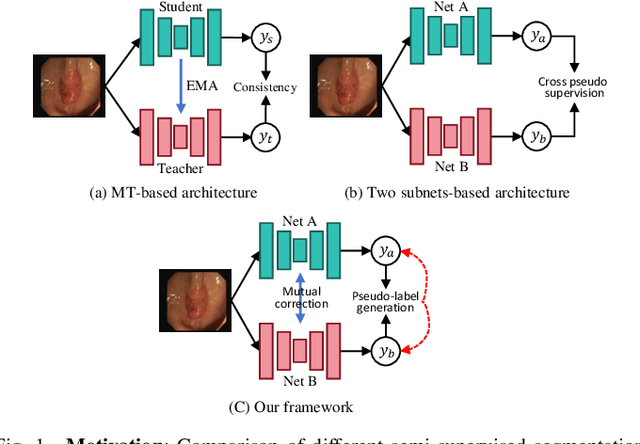
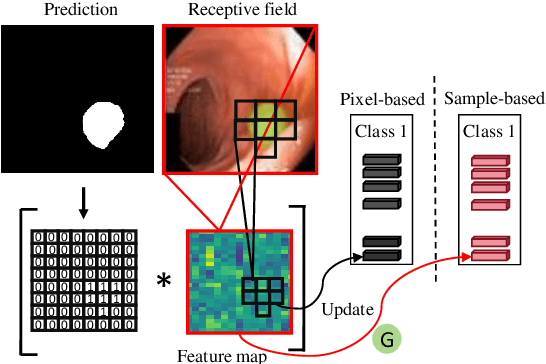
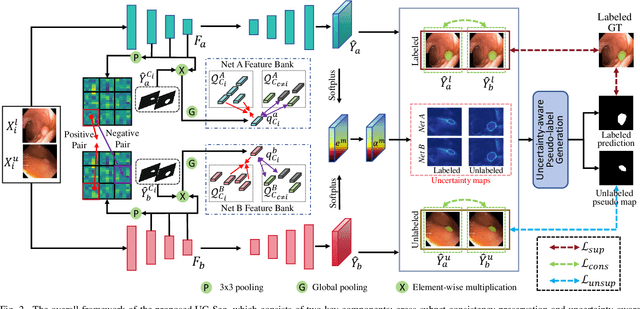
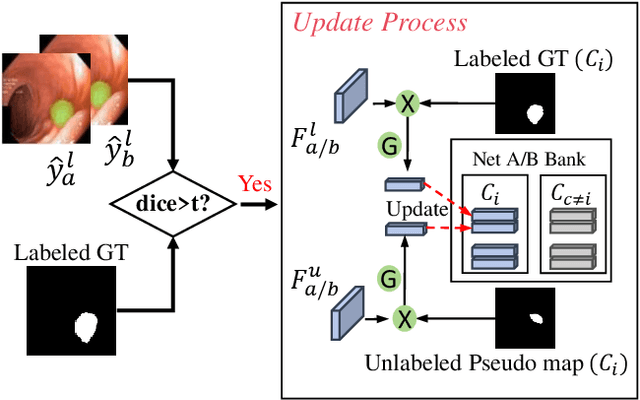
Abstract:Semi-supervised learning has gained considerable popularity in medical image segmentation tasks due to its capability to reduce reliance on expert-examined annotations. Several mean-teacher (MT) based semi-supervised methods utilize consistency regularization to effectively leverage valuable information from unlabeled data. However, these methods often heavily rely on the student model and overlook the potential impact of cognitive biases within the model. Furthermore, some methods employ co-training using pseudo-labels derived from different inputs, yet generating high-confidence pseudo-labels from perturbed inputs during training remains a significant challenge. In this paper, we propose an Uncertainty-aware Cross-training framework for semi-supervised medical image Segmentation (UC-Seg). Our UC-Seg framework incorporates two distinct subnets to effectively explore and leverage the correlation between them, thereby mitigating cognitive biases within the model. Specifically, we present a Cross-subnet Consistency Preservation (CCP) strategy to enhance feature representation capability and ensure feature consistency across the two subnets. This strategy enables each subnet to correct its own biases and learn shared semantics from both labeled and unlabeled data. Additionally, we propose an Uncertainty-aware Pseudo-label Generation (UPG) component that leverages segmentation results and corresponding uncertainty maps from both subnets to generate high-confidence pseudo-labels. We extensively evaluate the proposed UC-Seg on various medical image segmentation tasks involving different modality images, such as MRI, CT, ultrasound, colonoscopy, and so on. The results demonstrate that our method achieves superior segmentation accuracy and generalization performance compared to other state-of-the-art semi-supervised methods. Our code will be released at https://github.com/taozh2017/UCSeg.
AutoIAD: Manager-Driven Multi-Agent Collaboration for Automated Industrial Anomaly Detection
Aug 07, 2025Abstract:Industrial anomaly detection (IAD) is critical for manufacturing quality control, but conventionally requires significant manual effort for various application scenarios. This paper introduces AutoIAD, a multi-agent collaboration framework, specifically designed for end-to-end automated development of industrial visual anomaly detection. AutoIAD leverages a Manager-Driven central agent to orchestrate specialized sub-agents (including Data Preparation, Data Loader, Model Designer, Trainer) and integrates a domain-specific knowledge base, which intelligently handles the entire pipeline using raw industrial image data to develop a trained anomaly detection model. We construct a comprehensive benchmark using MVTec AD datasets to evaluate AutoIAD across various LLM backends. Extensive experiments demonstrate that AutoIAD significantly outperforms existing general-purpose agentic collaboration frameworks and traditional AutoML frameworks in task completion rate and model performance (AUROC), while effectively mitigating issues like hallucination through iterative refinement. Ablation studies further confirm the crucial roles of the Manager central agent and the domain knowledge base module in producing robust and high-quality IAD solutions.
StreamME: Simplify 3D Gaussian Avatar within Live Stream
Jul 22, 2025Abstract:We propose StreamME, a method focuses on fast 3D avatar reconstruction. The StreamME synchronously records and reconstructs a head avatar from live video streams without any pre-cached data, enabling seamless integration of the reconstructed appearance into downstream applications. This exceptionally fast training strategy, which we refer to as on-the-fly training, is central to our approach. Our method is built upon 3D Gaussian Splatting (3DGS), eliminating the reliance on MLPs in deformable 3DGS and relying solely on geometry, which significantly improves the adaptation speed to facial expression. To further ensure high efficiency in on-the-fly training, we introduced a simplification strategy based on primary points, which distributes the point clouds more sparsely across the facial surface, optimizing points number while maintaining rendering quality. Leveraging the on-the-fly training capabilities, our method protects the facial privacy and reduces communication bandwidth in VR system or online conference. Additionally, it can be directly applied to downstream application such as animation, toonify, and relighting. Please refer to our project page for more details: https://songluchuan.github.io/StreamME/.
Text-driven Multiplanar Visual Interaction for Semi-supervised Medical Image Segmentation
Jul 16, 2025Abstract:Semi-supervised medical image segmentation is a crucial technique for alleviating the high cost of data annotation. When labeled data is limited, textual information can provide additional context to enhance visual semantic understanding. However, research exploring the use of textual data to enhance visual semantic embeddings in 3D medical imaging tasks remains scarce. In this paper, we propose a novel text-driven multiplanar visual interaction framework for semi-supervised medical image segmentation (termed Text-SemiSeg), which consists of three main modules: Text-enhanced Multiplanar Representation (TMR), Category-aware Semantic Alignment (CSA), and Dynamic Cognitive Augmentation (DCA). Specifically, TMR facilitates text-visual interaction through planar mapping, thereby enhancing the category awareness of visual features. CSA performs cross-modal semantic alignment between the text features with introduced learnable variables and the intermediate layer of visual features. DCA reduces the distribution discrepancy between labeled and unlabeled data through their interaction, thus improving the model's robustness. Finally, experiments on three public datasets demonstrate that our model effectively enhances visual features with textual information and outperforms other methods. Our code is available at https://github.com/taozh2017/Text-SemiSeg.
 Add to Chrome
Add to Chrome Add to Firefox
Add to Firefox Add to Edge
Add to Edge